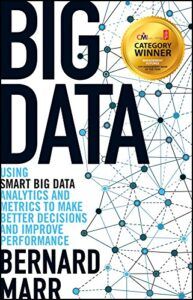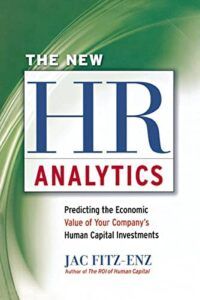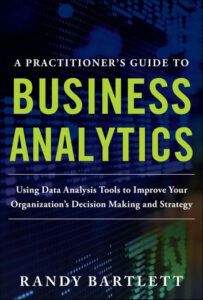You found our list of the top people analytics books.
People analytics books are publications that focus on using data to improve employee management and performance. Examples include Data Strategy by Bernard Marr, The Model Thinker by Scott E. Page, and Data Driven by Thomas C. Redman. The purpose of these books is to provide readers with clear workforce insights that will increase organizational performance. People analytics books are also sometimes called HR analytics books.
These books provide HR tips and guides to boost HR skills. HR professionals can use lessons from people analytics books to create a positive work environment.

This list includes:
- HR analytics books
- guides to people analytics
- people analytics books for beginners
- human capital analytics books
Here we go!
List of people analytics books
People analytics books provide comprehensive insights into human resource-related topics, such as recruitment, retention, and workforce engagement. From People Analytics in the Era of Big Data by Jean Paul Isson and Jesse S. Harriott to A Practitioner’s Guide to Business Analytics by Randy Bartlett, here is a list of the best books that provide insights on people analytics.
1. Big Data: Using SMART Big Data, Analytics and Metrics To Make Better Decisions and Improve Performance by Bernard Marr

Big Data tops the list of guides to people analytics. The author outlines simple big data strategies organizations can use to improve performance and get real-world business results. Through the publication, companies will also get a clear understanding and steps to build their big data strategies.
The author takes readers through the SMART model:
- Start with strategy
- Measure metrics and data
- Apply analytics
- Report results
- Transform
Murr addresses how organizations can use big data analytics to visualize and communicate key decisions. Readers will also get insights from some renowned global brands and leading organizations.
Notable Quote: ”As business leaders we need to understand that lack of data is not the issue. Most businesses have more than enough data to use constructively; we just don’t know how to use it. The reality is that most businesses are already data rich, but insight poor.”
Read Big Data.
2. People Analytics in the Era of Big Data: Changing the Way You Attract, Acquire, Develop, and Retain Talent by Jean Paul Isson and Jesse S. Harriott

People Analytics in the Era of Big Data provides strategies to help organizations capitalize on predictive analytics in workforce management. The resource is a blueprint for any company that wants to leverage the talent pool through data analytics. Jean Paul Isson and Jesse S. Harriot provide actionable insights that can help in workforce sourcing, recruiting, engagement, promotion, and retention. Through the resource, readers will learn ways to utilize analytics techniques for workforce management and optimize tools at their disposal. The book bases the lessons on examples of workforce analytics in the US, Europe, Canada, Australia, and Asia.
Notable Quote: ”Top personnel create the best new products, make the most revenue, and find the greatest efficiencies. They build great workplaces, delight customers, and attract others like themselves to join the organization. They adapt to changing business conditions. Finding, managing, and holding that top talent is the key to your future.”
Read People Analytics in the Era of Big Data.
Get our free team building toolbox
- icebreaker games
- bingo cards
- DIY guides
 by teams at FedEx, Amazon, Deloitte and 73,930+ others
by teams at FedEx, Amazon, Deloitte and 73,930+ others

3. Data Strategy: How to Profit from a World of Big Data, Analytics and the Internet of Things by Bernard Marr

If you are looking for HR analytics books, then Data Strategy is a good bet. Bernard Marr recognizes that organizations use and analyze less than 0.5% of data. However, with the revolutionization of data, businesses cannot afford to be skeptical and unconcerned about statistics. The author provides a data strategy enabling companies to thrive and survive even through the toughest situations. Marr explains how businesses can identify strategic data needs and collection methods. Readers also get insights into data translation tips that will give businesses a competitive advantage. The book uses real-world examples and case studies to equip businesses with the strategies and tools that will ensure businesses profit from big data analytics.
Notable Quote: ”If every business, regardless of size, is now a data business, every business therefore needs a robust data strategy.”
Read Data Strategy.
4. People Skills for Analytical Thinkers by Gilbert Eijkelenboom

Through his keen interest in data and psychology, Gilbert Eijkelenboom is a key player in helping data professionals acquire and use communication skills. While the author recognizes that analytical skills are incredibly valuable, Eijkelenboom talks about the importance of presentation skills in data. The book can help HR professionals leverage data through good people skills and communication skills. People Skills for Analytical Thinkers also uses analytical language to describe people’s behavior. Readers will get analytical thinking insights through exercises, academic sources, and stories.
Notable Quote: ”Your algorithms are like a highway; you have taken that route every time in your life because the highway is fast and easy. Your new algorithm is a hidden path through the undergrowth where you have to cut down bushes along the way. If you keep forcing yourself up the hidden path, it eventually becomes the highway. The old highway gets overgrown and forgotten about.”
Read People Skills for Analytical Thinkers.
5. The New HR Analytics: Predicting the Economic Value of Your Company’s Human Capital Investments by Jac Fitz-Enz

The New HR Analytics is a great choice of human capital analytics books. In the resource, Jac Fitz-Enz helps readers make HR investment predictions through the author’s proprietary analytical method. The author also outlines ways HR professionals can make strategic staffing decisions. Readers will learn strategies that prioritize performance skills and use flexible capacity planning to build a lively workforce. The book also helps professionals identify and reward behaviors and implement a succession strategy that drives revenue growth. Fitz-Enz uses input from top human resource professionals, thought leaders, and real-world analytics examples.
Notable Quote: ”Nobody questions the importance of knowing what happens outside, but such knowledge should be preceded by knowing what happens inside. Generally, benchmarking will not help resolve incorrectly formulated questions or questions that are misdirected. Externalism can harm human capital management as much as self-centeredness can. An appropriate balance between looking outside and knowing the inside seems to be the obvious solution to this crisis.”
Read The New HR Analytics.
6. A Practitioner’s Guide to Business Analytics: Using Data Analysis Tools to Improve Your Organization’s Decision Making and Strategy: Using Data Analysis Tools to Improve Your Organization’s Decision Making and Strategy by Randy Bartlett

A Practitioner’s Guide to Business Analytics helps businesses get a competitive edge via business analytics. The book provides tips and insights to help enterprises solve challenges by applying strategic analytics. For instance, Randy Bartlett details how companies can integrate analytics into corporate culture, decision-making, and business strategy. The author also includes statistical diagnoses, qualifications, and reviews that businesses can leverage. The read also provides effective building blocks supporting data collection, analytics-statistical software, and data management. The author has vast experience in helping new businesses get sustainable analytics practices.
Notable Quote: ”Opinion-based decision making, statistical malfeasance, and counterfeit analysis are pandemic. We are swimming in make-believe analytics.”
Read A Practitioner’s Guide to Business Analytics.
7. Storytelling with Data: A Data Visualization Guide for Business Professionals by Cole Nussbaumer Knaflic

Storytelling with Data helps professionals capitalize on data by showcasing the power of storytelling. Cole Nussbaumer Knaflic urges readers to use storytelling techniques to communicate effectively and capture the audience’s attention. The book teaches readers the fundamentals of data visualization through real-world examples. The author also demonstrates how professionals can use data to create informative, engaging, and compelling stories. Through Storytelling with Data, readers will learn tips on recognizing and eliminating clutter from their data and directing audiences to the most important parts of their data. Professionals who are on the search for human capital analytics books will also benefit from Storytelling with Data.
Notable Quote: ”Further develop the situation or problem by covering relevant background. Incorporate external context or comparison points. Give examples that illustrate the issue. Include data that demonstrates the problem. Articulate what will happen if no action is taken or no change is made. Discuss potential options for addressing the problem. Illustrate the benefits of your recommended solution.”
Read Storytelling with Data.
8. Data & Analytics Reading Sampler by John Wiley & Sons

With excerpts from data analytic professionals, Data & Analytics Sampler is a great read for professionals. The e-book provides excerpts from data analytics writers, including Eric Siegel, Nathan Yau, Jason Lankow, Ross Crooks, and Lee Odden. Readers will get insight into various people analytics topics such as predictive analysis, infographics, data optimization, and social media metrics.
Notable Quote: ”It’s not hard to put a value on prediction. As you can see, even if predictions themselves are generated from sophisticated mathematics, it only takes simple arithmetic to roll up the plethora of predictions—some accurate, and others not so much—and reveal the aggregate bottom-line effect. This isn’t just some abstract notion; The Prediction Effect means business.”
Read Data & Analytics Reading Sampler.
9. Data Science for Business: What you need to know about data mining and data-analytic thinking by Foster Provost & Tom Fawcett

Data Science for Business provides tips for extracting useful knowledge and getting business value from data collection. The renowned data science experts provide fundamental principles to guide readers in data analytics. Through Data Science for Business, readers will learn how to use data to support business decisions, interview prospects, and competitive advantage. The book explains why organizations and professionals must treat data as a business asset and the importance of strategic data investments to gain substantial value. The book is also an excellent resource for readers who want to dive into data mining using current techniques.
Notable Quote: ”In analytics, it’s more important for individuals to be able to formulate problems well, to prototype solutions quickly, to make reasonable assumptions in the face of ill-structured problems, to design experiments that represent good investments, and to analyze results.”
Read Data Science for Business.
10. The Model Thinker: What You Need to Know to Make Data Work for You by Scott E. Page

The Model Thinker provides great insights for professionals who are on the search for guides to people analytics. Readers will learn how to use data like a pro. Scott E. Page provides readers with tips to understand, organize, and apply data. The author takes readers through statistical, mathematical, and computational models that any professional can use to their advantage. For instance, the book uses the author’s many-model paradigm to show leaders how to apply different models in data organization. Through these strategies, organizations can make accurate predictions that will lead to wiser business decisions.
Notable Quote: ”The models that characterize the robustness of neuronal networks bear little resemblance to the molecular biology models used to explain brain cell function, which in turn differ from the psychological models used to explain cognitive biases.”
Read The Model Thinker.
11. Introduction to People Analytics: A Practical Guide to Data-driven HR by Nadeem Khan, Dave Millner, & Bernard Marr

Introduction to People Analytics provides handy insights to individuals looking for people analytics books for beginners. The book recognizes the importance of people analytics for organizational success with a focus on the three Ds, which are data, digital, and design. The authors also focus on the interpretation of data from a human resource perspective. Additionally, the publication discusses the importance of data in business leadership and culture. Readers will learn to use data to increase workforce engagement, retention, and productivity. Introduction to People Analytics is a great read for HR professionals and organizational leaders.
Notable Quote: ”HR will not be replaced by data analytics, but HR who do not use data and analytics will be replaced by those who do.”
Read Introduction to People Analytics.
12. Big data @ work: dispelling the myths, uncovering the opportunities by Thomas H. Davenport

Big data @ work tops the list of people analytics books for beginners. Thomas H. Davenport uses conversational language to explain the meaning of big data and why every professional must find ways to leverage data. The book focuses on areas such as the meaning of big data from a consumer, management, and technical perspective. Readers will also get insights into the opportunities and costs of big data and its real business impact. Other notable lessons from Big data @ work include tips to use data to drive changes in organizations, jobs, and industries and data management technology. These insights can be fundamental in improving products, services, and business decisions. Davenport uses examples from companies such as Amazon, Citigroup, UPS, GE, and United Healthcare.
Notable Quote: ”One other problem is that too many people—and vendors in particular—are already using big data to mean any use of analytics, or in extreme cases even reporting and conventional business intelligence.”
Read Big data @ work.
13. The Future of Work: Attract New Talent, Build Better Leaders, and Create a Competitive Organization by Jacob Morgan

The Future of Work is a resource that recognizes the drastic changes in workplaces. Jacob Morgan seeks to use the resource to help businesses attract new talent, create competitive organizations, and build better leaders. The book also recognizes the constant introduction of new technologies in the workplace and provides tips on how businesses can use these tools to cut costs and boost performance. The author explores ways technologies reshape workplaces and the need to share information instead of hoarding it. Readers will also gain insights that can help to empower teams and create an environment that attracts and retains top talent.
Notable Quote: ”This means knowledge and experience are no longer the primary commodity. Instead, what is far more valuable is to have the ability to learn and to apply those learnings into new and unique scenarios. It’s no longer about what you know, it’s about how you can learn and adapt.”
Read The Future of Work.
14. Data Driven: Profiting from Your Most Important Business Asset by Thomas C. Redman

Data Driven is a worthy publication for businesses that want to leverage data. Thomas C. Redman provides data strategies to add value to business sectors such as management, workforce, finance, and product development. Readers will learn the hidden costs of poor-quality data, data exploitation tips, and ways to improve data quality. The book is an eye-opener for top executives, product-line managers, or aspiring readers.
Notable Quote: ”Information, then, teaches you about the world. Sometimes it does so by reducing your uncertainty about future events, and other times by enlarging your perspective.”
Read Data Driven.
Conclusion
People analytics books provide vital insights for seasoned professionals or people analytics beginners. These resources help individuals to understand the basics of HR analytics and strategies to drive better business performance. For instance, human resources can use big data and statistical insights to predict events and make better decisions. Most people analytics books also base their teaching on real-world examples and case studies that can help readers put theories into practice.
Next, check out our list of HR books, HR blogs, recruitment books, and HR training programs.
We also have a guide on HR automation practices and HR software tools.




